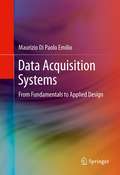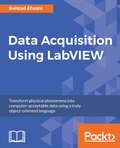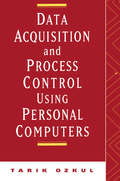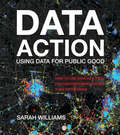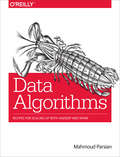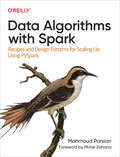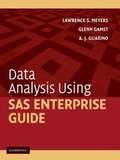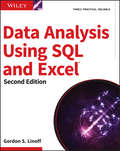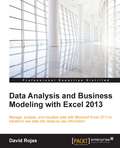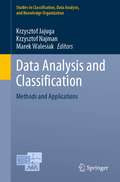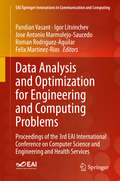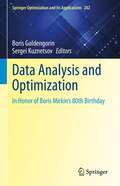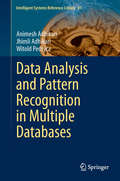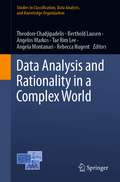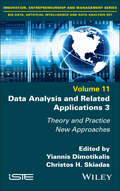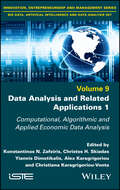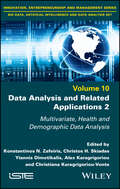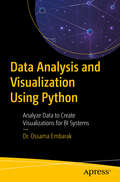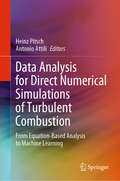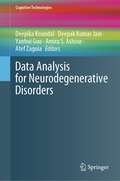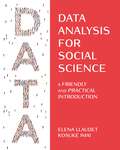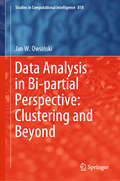- Table View
- List View
Data Acquisition Systems: From Fundamentals to Applied Design
by Maurizio Di Paolo EmilioThis book describes the fundamentals of data acquisition systems, how they enable users to sample signals that measure real physical conditions and convert the resulting samples into digital, numeric values that can be analyzed by a computer. The author takes a problem-solving approach to data acquisition, providing the tools engineers need to use the concepts introduced. Coverage includes sensors that convert physical parameters to electrical signals, signal conditioning circuitry to convert sensor signals into a form that can be converted to digital values and analog-to-digital converters, which convert conditioned sensor signals to digital values. Readers will benefit from the hands-on approach, culminating with data acquisition projects, including hardware and software needed to build data acquisition systems.
Data Acquisition Using LabVIEW
by Behzad EhsaniTransform physical phenomena into computer-acceptable data using a truly object-oriented language About This Book • Create your own data acquisition system independently using LabVIEW and build interactive dashboards • Collect data using National Instrument's and third-party, open source, affordable hardware • Step-by-step real-world examples using various tools that illustrate the fundamentals of data acquisition Who This Book Is For If you are an engineer, scientist, experienced hobbyist, or student, you will highly benefit from the content and examples illustrated in this book. A working knowledge of precision testing, measurement instruments, and electronics, as well as a background in computer fundamentals and programming is expected. What You Will Learn • Create a virtual instrument which highlights common functionality of LabVIEW • Get familiarized with common buses such as Serial, GPIB, and SCPI commands • Staircase signal acquisition using NI-DAQmx • Discover how to measure light intensity and distance • Master LabVIEW debugging techniques • Build a data acquisition application complete with an installer and required drivers • Utilize open source microcontroller Arduino and a 32-bit Arduino compatible Uno32 using LabVIEW programming environment In Detail NI LabVIEW's intuitive graphical interface eliminates the steep learning curve associated with text-based languages such as C or C++. LabVIEW is a proven and powerful integrated development environment to interact with measurement and control hardware, analyze data, publish results, and distribute systems. This hands-on tutorial guide helps you harness the power of LabVIEW for data acquisition. This book begins with a quick introduction to LabVIEW, running through the fundamentals of communication and data collection. Then get to grips with the auto-code generation feature of LabVIEW using its GUI interface. You will learn how to use NI-DAQmax Data acquisition VIs, showing how LabVIEW can be used to appropriate a true physical phenomenon (such as temperature, light, and so on) and convert it to an appropriate data type that can be manipulated and analyzed with a computer. You will also learn how to create Distribution Kit for LabVIEW, acquainting yourself with various debugging techniques offered by LabVIEW to help you in situations where bugs are not letting you run your programs as intended. By the end of the book, you will have a clear idea how to build your own data acquisition system independently and much more. Style and approach A hands-on practical guide that starts by laying down the software and hardware foundations necessary for subsequent data acquisition-intensive chapters. The book is packed full of specific examples with software screenshots and schematic diagrams to guide you through the creation of each virtual instrument.
Data Acquisition and Process Control Using Personal Computers
by Ozkul""Covers all areas of computer-based data acquisition--from basic concepts to the most recent technical developments--without the burden of long theoretical derivations and proofs. Offers practical, solution-oriented design examples and real-life case studies in each chapter and furnishes valuable selection guides for specific types of hardware.
Data Action: Using Data for Public Good
by Sarah WilliamsHow to use data as a tool for empowerment rather than oppression.Big data can be used for good--from tracking disease to exposing human rights violations--and for bad--implementing surveillance and control. Data inevitably represents the ideologies of those who control its use; data analytics and algorithms too often exclude women, the poor, and ethnic groups. In Data Action, Sarah Williams provides a guide for working with data in more ethical and responsible ways. Too often data has been used--and manipulated--to make policy decisions without much stakeholder input. Williams outlines a method that emphasizes collaboration among data scientists, policy experts, data designers, and the public. This approach creates trust and co-ownership in the data by opening the process to those who know the issues best.
Data Algorithms
by Mahmoud ParsianIf you are ready to dive into the MapReduce framework for processing large datasets, this practical book takes you step by step through the algorithms and tools you need to build distributed MapReduce applications with Apache Hadoop or Apache Spark. Each chapter provides a recipe for solving a massive computational problem, such as building a recommendation system. You'll learn how to implement the appropriate MapReduce solution with code that you can use in your projects.Dr. Mahmoud Parsian covers basic design patterns, optimization techniques, and data mining and machine learning solutions for problems in bioinformatics, genomics, statistics, and social network analysis. This book also includes an overview of MapReduce, Hadoop, and Spark.Topics include:Market basket analysis for a large set of transactionsData mining algorithms (K-means, KNN, and Naive Bayes)Using huge genomic data to sequence DNA and RNANaive Bayes theorem and Markov chains for data and market predictionRecommendation algorithms and pairwise document similarityLinear regression, Cox regression, and Pearson correlationAllelic frequency and mining DNASocial network analysis (recommendation systems, counting triangles, sentiment analysis)
Data Algorithms with Spark: Recipes and Design Patterns for Scaling Up using PySpark
by Mahmoud ParsianApache Spark's speed, ease of use, sophisticated analytics, and multilanguage support makes practical knowledge of this cluster-computing framework a required skill for data engineers and data scientists. With this hands-on guide, anyone looking for an introduction to Spark will learn practical algorithms and examples using PySpark.In each chapter, author Mahmoud Parsian shows you how to solve a data problem with a set of Spark transformations and algorithms. You'll learn how to tackle problems involving ETL, design patterns, machine learning algorithms, data partitioning, and genomics analysis. Each detailed recipe includes PySpark algorithms using the PySpark driver and shell script.With this book, you will:Learn how to select Spark transformations for optimized solutionsExplore powerful transformations and reductions including reduceByKey(), combineByKey(), and mapPartitions()Understand data partitioning for optimized queriesBuild and apply a model using PySpark design patternsApply motif-finding algorithms to graph dataAnalyze graph data by using the GraphFrames APIApply PySpark algorithms to clinical and genomics dataLearn how to use and apply feature engineering in ML algorithmsUnderstand and use practical and pragmatic data design patterns
Data Algorithms: Recipes for Scaling Up with Hadoop and Spark
by Mahmoud ParsianIf you are ready to dive into the MapReduce framework for processing large datasets, this practical book takes you step by step through the algorithms and tools you need to build distributed MapReduce applications with Apache Hadoop or Apache Spark. Each chapter provides a recipe for solving a massive computational problem, such as building a recommendation system. You’ll learn how to implement the appropriate MapReduce solution with code that you can use in your projects.Dr. Mahmoud Parsian covers basic design patterns, optimization techniques, and data mining and machine learning solutions for problems in bioinformatics, genomics, statistics, and social network analysis. This book also includes an overview of MapReduce, Hadoop, and Spark.Topics include:Market basket analysis for a large set of transactionsData mining algorithms (K-means, KNN, and Naive Bayes)Using huge genomic data to sequence DNA and RNANaive Bayes theorem and Markov chains for data and market predictionRecommendation algorithms and pairwise document similarityLinear regression, Cox regression, and Pearson correlationAllelic frequency and mining DNASocial network analysis (recommendation systems, counting triangles, sentiment analysis)
Data Analysis Using SAS Enterprise Guide
by Lawrence S. Meyers Glenn Gamst A. J. GuarinoThis book presents the basic procedures for utilizing SAS Enterprise Guide to analyze statistical data. SAS Enterprise Guide is a graphical user interface (point and click) to the main SAS application. Each chapter contains a brief conceptual overview and then guides the reader through concrete step-by-step examples to complete the analyses. The eleven sections of the book cover a wide range of statistical procedures including descriptive statistics, correlation and simple regression, t tests, one-way chi square, data transformations, multiple regression, analysis of variance, analysis of covariance, multivariate analysis of variance, factor analysis, and canonical correlation analysis. Designed to be used either as a stand-alone resource or as an accompaniment to a statistics course, the book offers a smooth path to statistical analysis with SAS Enterprise Guide for advanced undergraduate and beginning graduate students, as well as professionals in psychology, education, business, health, social work, sociology, and many other fields.
Data Analysis Using SAS Enterprise Guide
by Lawrence S. Meyers Glenn Gamst A. J. Guarino Lawrence S. Meyers Glenn GamstThis book presents the basic procedures for utilizing SAS Enterprise Guide to analyze statistical data. SAS Enterprise Guide is a graphical user interface (point and click) to the main SAS application. Each chapter contains a brief conceptual overview and then guides the reader through concrete step-by-step examples to complete the analyses. The eleven sections of the book cover a wide range of statistical procedures including descriptive statistics, correlation and simple regression, t tests, one-way chi square, data transformations, multiple regression, analysis of variance, analysis of covariance, multivariate analysis of variance, factor analysis, and canonical correlation analysis. Designed to be used either as a stand-alone resource or as an accompaniment to a statistics course, the book offers a smooth path to statistical analysis with SAS Enterprise Guide for advanced undergraduate and beginning graduate students, as well as professionals in psychology, education, business, health, social work, sociology, and many other fields.
Data Analysis Using SQL and Excel
by Gordon S. LinoffUseful business analysis requires you to effectively transform data into actionable information. This book helps you use SQL and Excel to extract business information from relational databases and use that data to define business dimensions, store transactions about customers, produce results, and more. Each chapter explains when and why to perform a particular type of business analysis in order to obtain useful results, how to design and perform the analysis using SQL and Excel, and what the results should look like.
Data Analysis and Business Modeling with Excel 2013
by David RojasManage, analyze, and visualize data with Microsoft Excel 2013 to transform raw data into ready to use informationAbout This BookCreate formulas to help you analyze and explain findingsDevelop interactive spreadsheets that will impress your audience and give them the ability to slice and dice dataA step-by-step guide to learn various ways to model data for businesses with the help of Excel 2013Who This Book Is ForIf you want to start using Excel 2013 for data analysis and business modeling and enhance your skills in the data analysis life cycle then this book is for you, whether you're new to Excel or experienced.What You Will LearnDiscover what Excel formulas are all about and how to use them in your spreadsheet developmentIdentify bad data and learn cleaning strategiesCreate interactive spreadsheets that engage and appeal to your audienceLeverage Excel's powerful built-in tools to get the median, maximum, and minimum values of your dataBuild impressive tables and combine datasets using Excel's built-in functionalityLearn the powerful scripting language VBA, allowing you to implement your own custom solutions with easeIn DetailExcel 2013 is one of the easiest to use data analysis tools you will ever come across. Its simplicity and powerful features has made it the go to tool for all your data needs. Complex operations with Excel, such as creating charts and graphs, visualization, and analyzing data make it a great tool for managers, data scientists, financial data analysts, and those who work closely with data. Learning data analysis and will help you bring your data skills to the next level.This book starts by walking you through creating your own data and bringing data into Excel from various sources. You'll learn the basics of SQL syntax and how to connect it to a Microsoft SQL Server Database using Excel's data connection tools. You will discover how to spot bad data and strategies to clean that data to make it useful to you. Next, you'll learn to create custom columns, identify key metrics, and make decisions based on business rules. You'll create macros using VBA and use Excel 2013's shiny new macros. Finally, at the end of the book, you'll be provided with useful shortcuts and tips, enabling you to do efficient data analysis and business modeling with Excel 2013.Style and approachThis is a step-by-step guide to performing data analysis and business modelling with Excel 2013, complete with examples and tips.
Data Analysis and Classification: Methods and Applications (Studies in Classification, Data Analysis, and Knowledge Organization)
by Krzysztof Jajuga Marek Walesiak Krzysztof NajmanThis volume gathers peer-reviewed contributions that address a wide range of recent developments in the methodology and applications of data analysis and classification tools in micro and macroeconomic problems. The papers were originally presented at the 29th Conference of the Section on Classification and Data Analysis of the Polish Statistical Association, SKAD 2020, held in Sopot, Poland, September 7–9, 2020. Providing a balance between methodological contributions and empirical papers, the book is divided into five parts focusing on methodology, finance, economics, social issues and applications dealing with COVID-19 data. It is aimed at a wide audience, including researchers at universities and research institutions, graduate and doctoral students, practitioners, data scientists and employees in public statistical institutions.
Data Analysis and Optimization for Engineering and Computing Problems: Proceedings of the 3rd EAI International Conference on Computer Science and Engineering and Health Services (EAI/Springer Innovations in Communication and Computing)
by Pandian Vasant Igor Litvinchev Jose Antonio Marmolejo-Saucedo Roman Rodriguez-Aguilar Felix Martinez-RiosThis book presents the proceedings of The EAI International Conference on Computer Science: Applications in Engineering and Health Services (COMPSE 2019). The conference highlighted the latest research innovations and applications of algorithms designed for optimization applications within the fields of Science, Computer Science, Engineering, Information Technology, Management, Finance and Economics and Health Systems. Focusing on a variety of methods and systems as well as practical examples, this conference is a significant resource for post graduate-level students, decision makers, and researchers in both public and private sectors who are seeking research-based methods for modelling uncertain and unpredictable real-world problems.
Data Analysis and Optimization: In Honor of Boris Mirkin's 80th Birthday (Springer Optimization and Its Applications #202)
by Boris Goldengorin Sergei KuznetsovThis book presents the state-of-the-art in the emerging field of data science and includes models for layered security with applications in the protection of sites—such as large gathering places—through high-stake decision-making tasks. Such tasks include cancer diagnostics, self-driving cars, and others where wrong decisions can possibly have catastrophic consequences. Additionally, this book provides readers with automated methods to analyze patterns and models for various types of data, with applications ranging from scientific discovery to business intelligence and analytics. The book primarily includes exploratory data analysis, pattern mining, clustering, and classification supported by real life case studies. The statistical section of this book explores the impact of data mining and modeling on the predictability assessment of time series. Further new notions of mean values based on ideas of multi-criteria optimization are compared with their conventional definitions, leading to new algorithmic approaches to the calculation of the suggested new means. The style of the written chapters and the provision of a broad yet in-depth overview of data mining, integrating novel concepts from machine learning and statistics, make the book accessible to upper level undergraduate and graduate students in data mining courses. Students and professionals specializing in computer and management science, data mining for high-dimensional data, complex graphs and networks will benefit from the cutting-edge ideas and practically motivated case studies in this book.
Data Analysis and Pattern Recognition in Multiple Databases (Intelligent Systems Reference Library #61)
by Witold Pedrycz Animesh Adhikari Jhimli AdhikariPattern recognition in data is a well known classical problem that falls under the ambit of data analysis. As we need to handle different data, the nature of patterns, their recognition and the types of data analyses are bound to change. Since the number of data collection channels increases in the recent time and becomes more diversified, many real-world data mining tasks can easily acquire multiple databases from various sources. In these cases, data mining becomes more challenging for several essential reasons. We may encounter sensitive data originating from different sources - those cannot be amalgamated. Even if we are allowed to place different data together, we are certainly not able to analyze them when local identities of patterns are required to be retained. Thus, pattern recognition in multiple databases gives rise to a suite of new, challenging problems different from those encountered before. Association rule mining, global pattern discovery and mining patterns of select items provide different patterns discovery techniques in multiple data sources. Some interesting item-based data analyses are also covered in this book. Interesting patterns, such as exceptional patterns, icebergs and periodic patterns have been recently reported. The book presents a thorough influence analysis between items in time-stamped databases. The recent research on mining multiple related databases is covered while some previous contributions to the area are highlighted and contrasted with the most recent developments.
Data Analysis and Rationality in a Complex World (Studies in Classification, Data Analysis, and Knowledge Organization)
by Angela Montanari Berthold Lausen Theodore Chadjipadelis Angelos Markos Tae Rim Lee Rebecca NugentThis volume presents the latest advances in statistics and data science, including theoretical, methodological and computational developments and practical applications related to classification and clustering, data gathering, exploratory and multivariate data analysis, statistical modeling, and knowledge discovery and seeking. It includes contributions on analyzing and interpreting large, complex and aggregated datasets, and highlights numerous applications in economics, finance, computer science, political science and education. It gathers a selection of peer-reviewed contributions presented at the 16th Conference of the International Federation of Classification Societies (IFCS 2019), which was organized by the Greek Society of Data Analysis and held in Thessaloniki, Greece, on August 26-29, 2019.
Data Analysis and Related Applications 3: Theory and Practice, New Approaches
by Christos H. Skiadas Yiannis DimotikalisThe book is a collective work by a number of leading scientists, analysts, engineers, mathematicians and statisticians who have been working at the forefront of data analysis and related applications, arising from data science, operations research, engineering, machine learning or statistics. The chapters of this collaborative work represent a cross-section of current research interests in the above scientific areas. The collected material has been divided into appropriate sections to provide the reader with both theoretical and applied information on data analysis methods, models and techniques, along with appropriate applications. The published data analysis methodology includes the updated state-of-the-art rapidly developed theory and applications of data expansion, both of which go through outstanding changes nowadays. New approaches are expected to deliver and have been developed, including Artificial Intelligence.
Data Analysis and Related Applications, Volume 1: Computational, Algorithmic and Applied Economic Data Analysis
by Alex Karagrigoriou Christos H. Skiadas Yiannis Dimotikalis Konstantinos N. Zafeiris Christiana Karagrigoriou-VontaThe scientific field of data analysis is constantly expanding due to the rapid growth of the computer industry and the wide applicability of computational and algorithmic techniques, in conjunction with new advances in statistical, stochastic and analytic tools. There is a constant need for new, high-quality publications to cover the recent advances in all fields of science and engineering.This book is a collective work by a number of leading scientists, computer experts, analysts, engineers, mathematicians, probabilists and statisticians who have been working at the forefront of data analysis and related applications. The chapters of this collaborative work represent a cross-section of current concerns, developments and research interests in the above scientific areas. The collected material has been divided into appropriate sections to provide the reader with both theoretical and applied information on data analysis methods, models and techniques, along with related applications.
Data Analysis and Related Applications, Volume 2: Multivariate, Health and Demographic Data Analysis
by Alex Karagrigoriou Christos H. Skiadas Yiannis Dimotikalis Konstantinos N. Zafeiris Christiana Karagrigoriou-VontaThe scientific field of data analysis is constantly expanding due to the rapid growth of the computer industry and the wide applicability of computational and algorithmic techniques, in conjunction with new advances in statistical, stochastic and analytic tools. There is a constant need for new, high-quality publications to cover the recent advances in all fields of science and engineering.This book is a collective work by a number of leading scientists, computer experts, analysts, engineers, mathematicians, probabilists and statisticians who have been working at the forefront of data analysis and related applications. The chapters of this collaborative work represent a cross-section of current concerns, developments and research interests in the above scientific areas. The collected material has been divided into appropriate sections to provide the reader with both theoretical and applied information on data analysis methods, models and techniques, along with related applications.
Data Analysis and Visualization Using Python: Analyze Data to Create Visualizations for BI Systems
by Dr Ossama EmbarakLook at Python from a data science point of view and learn proven techniques for data visualization as used in making critical business decisions. Starting with an introduction to data science with Python, you will take a closer look at the Python environment and get acquainted with editors such as Jupyter Notebook and Spyder. After going through a primer on Python programming, you will grasp fundamental Python programming techniques used in data science. Moving on to data visualization, you will see how it caters to modern business needs and forms a key factor in decision-making. You will also take a look at some popular data visualization libraries in Python. Shifting focus to data structures, you will learn the various aspects of data structures from a data science perspective. You will then work with file I/O and regular expressions in Python, followed by gathering and cleaning data. Moving on to exploring and analyzing data, you will look at advanced data structures in Python. Then, you will take a deep dive into data visualization techniques, going through a number of plotting systems in Python. In conclusion, you will complete a detailed case study, where you’ll get a chance to revisit the concepts you’ve covered so far.What You Will LearnUse Python programming techniques for data scienceMaster data collections in Python Create engaging visualizations for BI systemsDeploy effective strategies for gathering and cleaning dataIntegrate the Seaborn and Matplotlib plotting systemsWho This Book Is ForDevelopers with basic Python programming knowledge looking to adopt key strategies for data analysis and visualizations using Python.
Data Analysis for Direct Numerical Simulations of Turbulent Combustion: From Equation-Based Analysis to Machine Learning
by Heinz Pitsch Antonio AttiliThis book presents methodologies for analysing large data sets produced by the direct numerical simulation (DNS) of turbulence and combustion. It describes the development of models that can be used to analyse large eddy simulations, and highlights both the most common techniques and newly emerging ones. The chapters, written by internationally respected experts, invite readers to consider DNS of turbulence and combustion from a formal, data-driven standpoint, rather than one led by experience and intuition. This perspective allows readers to recognise the shortcomings of existing models, with the ultimate goal of quantifying and reducing model-based uncertainty. In addition, recent advances in machine learning and statistical inferences offer new insights on the interpretation of DNS data. The book will especially benefit graduate-level students and researchers in mechanical and aerospace engineering, e.g. those with an interest in general fluid mechanics, applied mathematics, and the environmental and atmospheric sciences.
Data Analysis for Neurodegenerative Disorders (Cognitive Technologies)
by Amira S. Ashour Yanhui Guo Deepika Koundal Deepak Kumar Jain Atef ZaguiaThis book explores the challenges involved in handling medical big data in the diagnosis of neurological disorders. It discusses how to optimally reduce the number of neuropsychological tests during the classification of these disorders by using feature selection methods based on the diagnostic information of enrolled subjects. The book includes key definitions/models and covers their applications in different types of signal/image processing for neurological disorder data. An extensive discussion on the possibility of enhancing the abilities of AI systems using the different data analysis is included. The book recollects several applicable basic preliminaries of the different AI networks and models, while also highlighting basic processes in image processing for various neurological disorders. It also reports on several applications to image processing and explores numerous topics concerning the role of big data analysis in addressing signal and image processing in various real-world scenarios involving neurological disorders.This cutting-edge book highlights the analysis of medical data, together with novel procedures and challenges for handling neurological signals and images. It will help engineers, researchers and software developers to understand the concepts and different models of AI and data analysis. To help readers gain a comprehensive grasp of the subject, it focuses on three key features:● Presents outstanding concepts and models for using AI in clinical applications involving neurological disorders, with clear descriptions of image representation, feature extraction and selection.● Highlights a range of techniques for evaluating the performance of proposed CAD systems for the diagnosis of neurological disorders.● Examines various signal and image processing methods for efficient decision support systems. Soft computing, machine learning and optimization algorithms are also included to improve the CAD systems used.
Data Analysis for Physical Scientists
by Les KirkupThe ability to summarise data, compare models and apply computer-based analysis tools are vital skills necessary for studying and working in the physical sciences. This textbook supports undergraduate students as they develop and enhance these skills. Introducing data analysis techniques, this textbook pays particular attention to the internationally recognised guidelines for calculating and expressing measurement uncertainty. This new edition has been revised to incorporate Excel® 2010. It also provides a practical approach to fitting models to data using non-linear least squares, a powerful technique which can be applied to many types of model. Worked examples using actual experimental data help students understand how the calculations apply to real situations. Over 200 in-text exercises and end-of-chapter problems give students the opportunity to use the techniques themselves and gain confidence in applying them. Answers to the exercises and problems are given at the end of the book.
Data Analysis for Social Science: A Friendly and Practical Introduction
by Kosuke Imai Elena LlaudetAn ideal textbook for complete beginners—teaches from scratch R, statistics, and the fundamentals of quantitative social scienceData Analysis for Social Science provides a friendly introduction to the statistical concepts and programming skills needed to conduct and evaluate social scientific studies. Assuming no prior knowledge of statistics and coding and only minimal knowledge of math, the book teaches the fundamentals of survey research, predictive models, and causal inference while analyzing data from published studies with the statistical program R. It teaches not only how to perform the data analyses but also how to interpret the results and identify the analyses&’ strengths and limitations.Progresses by teaching how to solve one kind of problem after another, bringing in methods as needed. It teaches, in this order, how to (1) estimate causal effects with randomized experiments, (2) visualize and summarize data, (3) infer population characteristics, (4) predict outcomes, (5) estimate causal effects with observational data, and (6) generalize from sample to population.Flips the script of traditional statistics textbooks. It starts by estimating causal effects with randomized experiments and postpones any discussion of probability and statistical inference until the final chapters. This unconventional order engages students by demonstrating from the very beginning how data analysis can be used to answer interesting questions, while reserving more abstract, complex concepts for later chapters.Provides a step-by-step guide to analyzing real-world data using the powerful, open-source statistical program R, which is free for everyone to use. The datasets are provided on the book&’s website so that readers can learn how to analyze data by following along with the exercises in the book on their own computer.Assumes no prior knowledge of statistics or coding.Specifically designed to accommodate students with a variety of math backgrounds. It includes supplemental materials for students with minimal knowledge of math and clearly identifies sections with more advanced material so that readers can skip them if they so choose.Provides cheatsheets of statistical concepts and R code.Comes with instructor materials (upon request), including sample syllabi, lecture slides, and additional replication-style exercises with solutions and with the real-world datasets analyzed. Looking for a more advanced introduction? Consider Quantitative Social Science by Kosuke Imai. In addition to covering the material in Data Analysis for Social Science, it teaches diffs-in-diffs models, heterogeneous effects, text analysis, and regression discontinuity designs, among other things.
Data Analysis in Bi-partial Perspective: Clustering and Beyond (Studies in Computational Intelligence #818)
by Jan W. OwsińskiThis book presents the bi-partial approach to data analysis, which is both uniquely general and enables the development of techniques for many data analysis problems, including related models and algorithms. It is based on adequate representation of the essential clustering problem: to group together the similar, and to separate the dissimilar. This leads to a general objective function and subsequently to a broad class of concrete implementations. Using this basis, a suboptimising procedure can be developed, together with a variety of implementations.This procedure has a striking affinity with the classical hierarchical merger algorithms, while also incorporating the stopping rule, based on the objective function. The approach resolves the cluster number issue, as the solutions obtained include both the content and the number of clusters. Further, it is demonstrated how the bi-partial principle can be effectively applied to a wide variety of problems in data analysis.The book offers a valuable resource for all data scientists who wish to broaden their perspective on basic approaches and essential problems, and to thus find answers to questions that are often overlooked or have yet to be solved convincingly. It is also intended for graduate students in the computer and data sciences, and will complement their knowledge and skills with fresh insights on problems that are otherwise treated in the standard “academic” manner.
